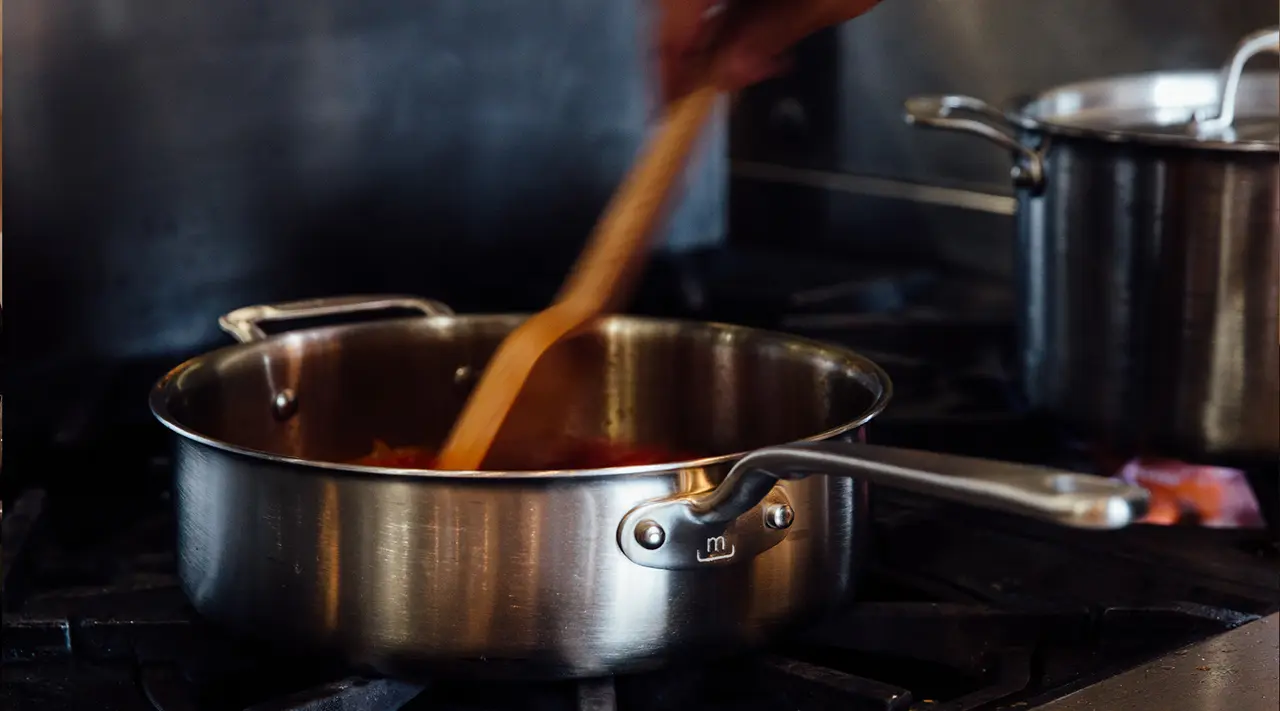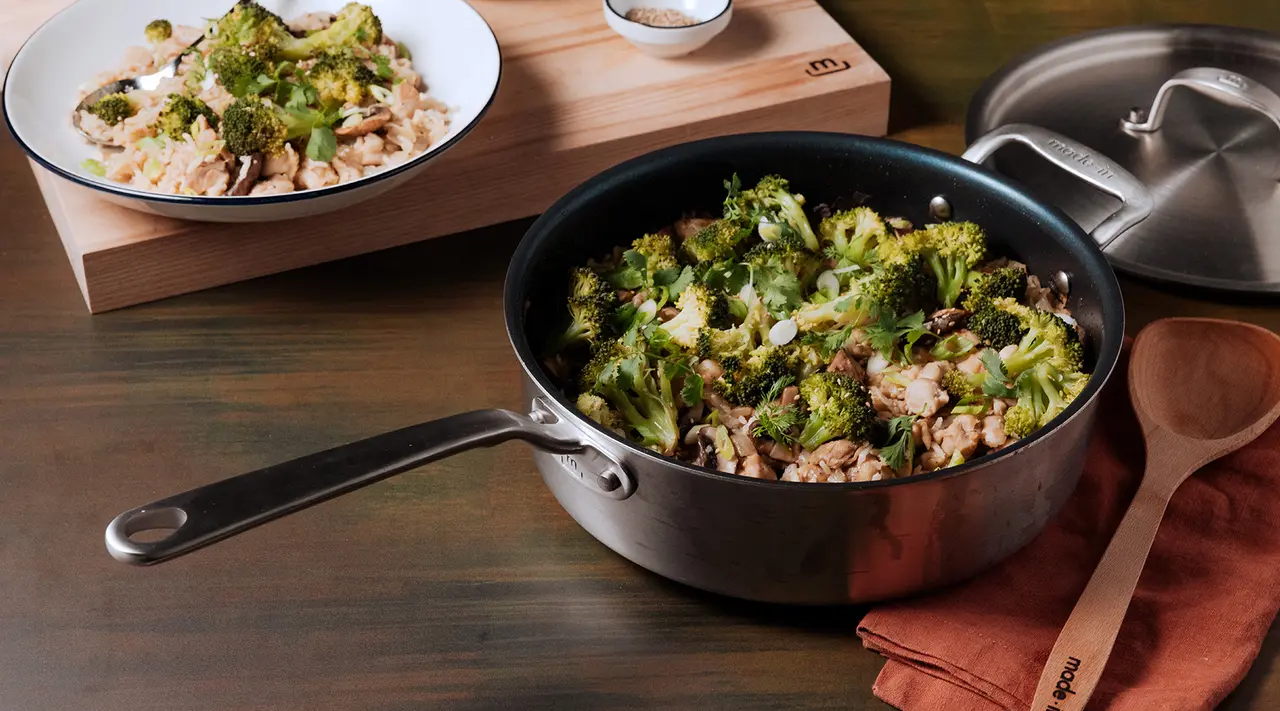“Pretty much any time I'm cooking in a pan I'm gonna start by sautéing,” says Chef Brandon Rice of Ernest in San Francisco. “Even searing meat in a pan is sautéing, right? It pays off every time. You're developing and layering that flavor.”
Derived from the French word for “jumped,” sautéing is a method of dry heat stovetop cooking in which ingredients are lightly fried with a small amount of fat in a shallow pan. If you’ve ever turned on a stove, chances are you’ve sautéed something, even if you didn’t know it.
It’s a foundational concept in cooking and for the most part instinctive, but there are a few tricks to doing it exactly as professionals do in restaurant kitchens.
What Is Sautéing?

Sautéing involves heating a wide, shallow pan—like a saute pan—over medium heat on the stovetop and cooking ingredients in a small amount of fat, usually until softened, golden brown, or both. It’s a method of “dry heat” cooking, which simply means that it doesn’t involve the addition of moisture. Other examples of dry heat cooking include deep frying, grilling, roasting, and baking.
When done properly, the texture softens and tenderizes and flavor develops and concentrates. “It really depends on what you're cooking, but you're gonna start most recipes by sweating things like onions, garlic, carrots, or celery to open up their flavors,” says Chef Rice.
What Ingredients Should Be Sautéed?
A few commonly sautéed foods include mushrooms, onions, garlic, mirepoix, sofrito, tender vegetables, and thin cuts of meat. This is ideally done in a saute pan, which has a wide cooking surface area and a shallow depth to better encourage browning and keep ingredients from steaming.
Appearance will be impacted, with vegetables taking on brighter hues and alliums fading to translucence. Depending on the heat used, anything that’s sautéed may take on a golden brown color, and all will shrink in volume as moisture evaporates.
How to Sauté Perfectly
Despite being an incredibly simple cooking method, there are a few techniques chefs rely on to ensure delicious results, both in your sautéing and the completed dish.
Choose the Right Pan
Naturally, a saute pan works best for sautéing, especially when you’re working with large quantities of ingredients. This pan is uniquely designed for building flavor early on for soups and stews and making sauce-based dishes and braises.
“The saute pan is very versatile compared to a frying pan, which is much more one dimensional,” says Chef Rice. “Let’s say you want to braise oxtails tonight. You start by roasting your oxtails in the oven while you sauté your alliums in the pan, and then you add your oxtails. You add your braising liquid to it, pop the top on, and put it in the oven. You're not gonna do that with a frying pan.”
That said, for simple sautéing tasks, a Frying Pan is a suitable substitute.
Preheat Carefully
Unless you’re using non stick cookware, preheating your pan is an essential step to prevent food from sticking. “The biggest mistake home cooks make is starting on a high heat and then keeping it on high heat,” says Chef Rice. “Start on a high heat until you see little wisps of smoke on the edge of the pan and then turn it down to a medium heat. At that point you can go in with oil and start sautéing.”
“A lot of people also put oil in the pan in the beginning and it does make a bit of a difference in the sauté and the sear you're gonna get,” cautions Chef Rice. “But you always want to turn down the heat to medium before you start sautéing. Depending on the power of your burner, the flame can get into the pan and catch on fire, and then your ingredients are gonna taste like gasoline.”
Uniformly Size Ingredients
It’s worth taking the extra time to uniformly slice, chop, dice, brunoise, or mince your ingredients. This will ensure they cook evenly and at a similar rate.
Additionally, you should be mindful of the size cuts you’re making. For example, “if you're sautéing carrots, you don't want to cut them really thick because they're gonna take too long to cook,” says Chef Rice. “So you might want to do like a brunoise or a small dice on that, or slice them thin on a mandoline. That goes for any root vegetables.”
Don’t Crowd the Pan
When sautéing, moisture is the enemy. For this reason, it’s important to refrain from crowding your pan, and instead keep everything in a single layer. When you crowd a pan, moisture gets trapped and results in steaming, rather than sautéing. This prevents ingredients from crisping and browning so you end up with soggy and underwhelming results. To prevent this, use a larger pan or sauté in batches.
Add Ingredients Safely
Whenever you’re adding ingredients to a hot pan, you run the risk of oil splattering and burning your fingers. To minimize this, Chef Rice recommends lifting the pan and tip it slightly forward when dropping in new ingredients. “I get the pan hot and go in with my fat, and then when I'm about to add ingredients, I tilt the pan forward just a little bit, lifting the handle upward,” says Chef Rice. “That way, if the oil splashes it goes forward instead of back at me.”
Ready to Cook?
Sautéing is a fundamental technique that every home cook should feel confident in, not least of all because it’s the foundation of most stovetop recipes. Now that you have the technical knowledge, you need the proper tool for the job: a Saute Pan. Your weeknight dinners will never be the same
























